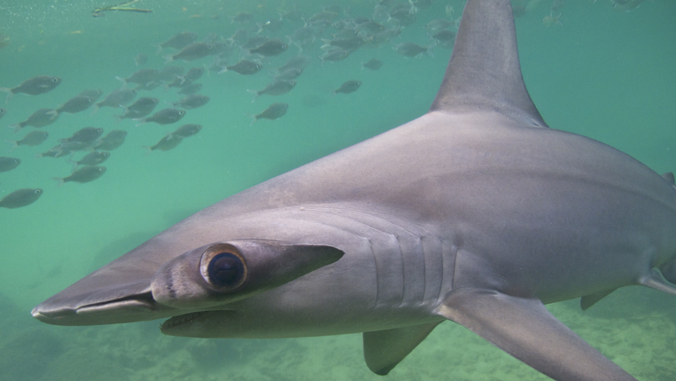
Cold-blooded scalloped hammerhead sharks (Sphryna lewini) keep themselves warm while diving into deep, cold water off Oʻahu, suggesting that the species might be holding its breath during dives to maintain its body temperature. That’s according to a recent study by Mark Royer, a marine biologist at the University of Hawaiʻi at Mānoa’s Hawaiʻi Institute of Marine Biology, who presented his research at the Ocean Sciences Meeting 2020 in San Diego, California, in February.
Scalloped hammerhead sharks usually assimilate to the surrounding water’s temperature and are not known to have physiological means to retain heat internally.
Royer tracked nine sharks for seven to 23 days. At night the sharks would make repeated (as many as seven) dives 800 meters below the surface, experiencing water temperatures as low as 5 degrees celsius (41 degrees fahrenheit). His research recorded the sharks’ depth, tailbeats and the pitch and roll of their bodies, as well as the temperature of their muscle and the surrounding water around Oʻahu.
Royer believes scalloped hammerhead sharks are shutting their mouths, or clamping their gills shut, while diving to prevent cold water flowing through their gills and avoid cooling their bodies down. This can help keep their muscles warm enough to hunt in deeper waters.
“Scalloped hammerheads are a tropical and warm temperate species. When their body temperature gets too low, they lose muscle function, visual acuity, and their metabolism slows down. If a shark gets too cold, it can’t keep itself moving to breathe,” Royer said.
Sharks breathe by pulling oxygen into their blood from ocean water as it rushes into their mouths and out through their gill slits. Hammerheads have to keep moving forward to avoid drowning. Water contact over the surface of their gills quickly cools or warms their blood to the temperature of the water.
“We don’t know what the mechanism is, whether it’s simply closing their mouths and closing their gills, or if they’re shunting the blood away from their gills. Either one of those mechanisms means there is no longer gas exchange at the gills, so the shark is basically holding its breath in a way that a shark can while it’s conducting these deep dives,” Royer said.
For more on the story, see the American Geophysical Union’s website.

